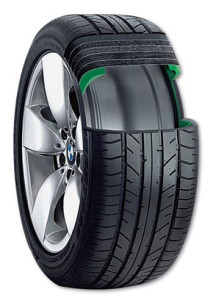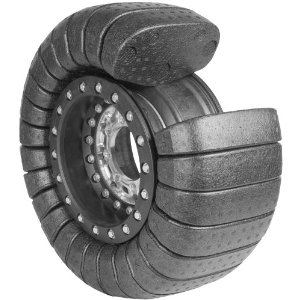Car Fortress 101 – Tires
We’ve written about making your ride safer on several occasions, and we’ve even touched on the subject of armored cars from time to time, but it’s been a while. That’s why we thought it was time to kick off a new series: Car Fortress 101, where we’ll show you no-nonsense ways that you can turn your regular, daily driver into a machine that can get you out of almost any sticky situation you might find yourself in, whether you’ve gotten yourself into the mess, or you’ve been put there by no fault of your own. Which can happen, we hear.
We’re going to start with the most basic of basics, and incidentally one of the most vulnerable part of any vehicle rolling around out there today; tires. If you drive a car, then chances are good you’ve got four of those things rolling along under you, so this applies to you, buddy!
Why Worry?

Tires are inherently vulnerable. They’re soft (well, relatively…), they’re rendered useless by even minor damage, and they’re absolutely crucial to the smooth ride you’re getting used to. If that seems like a bad combination, that’s because it is. Making your tires more resilient to damage can be the difference between getting away from a bad situation, and being brought down by one, so taking a little time to look at alternatives might just be the ticket to the ride of your life, so to speak.
There’s a few alternatives out there, available for anyone and at a reasonable price, in most cases, and we’re going to show you, starting right now.
Run-Flat Tires
Looks like an oxymoron, doesn’t it? That’s because it is. Tires can’t run if they’re flat, that’s almost the first bullet on the list of how a car works. You need tires that are not flat. Run-flat tires makes sure that even if your tires are damaged to the point where the air is let out, the tire won’t go completely flat. So they should probably be called Tires-that-won’t-go-completely-flat, but that just doesn’t sound as good.
How do they work?
A run-flat tire is a pneumatic vehicle tire that is designed to resist the effects of deflation when punctured, and to enable the vehicle to continue to be driven at reduced speeds (up to 55 mph (90 km/h), and for limited distances of up to 100 mi (160 km), or even 200 mi (320 km) depending on the type of tire.
So there you have it.
There are, basically, three types of run-flat tires; self-supporting, self-sealing and auxiliary supported tires. The first is the one we’re going to concentrate on, since that’s the best solution for security purposes. The other two are good, but can lull the user into a false sense of security – the self-supporting tire can maintain higher speeds for a longer distance than any of the others, which might be crucial.
Self-supporting tires:

This is pretty self-explanatory. Inside the tire, there’s a support structure that kicks in if the air goes away, which usually means that the car simply drops down onto the support structure, letting that carry the weight instead of the air.
Pros: you can still drive on, keeping up your speed.
Cons: It’s bound to be a bumpy ride.
The bumpy ride thing is what discourages most people, but they’re misguided; the bumpy thing kicks in if the tire goes flat, and it’s simply due to the fact that a solid, relatively unyielding wheel will feel bumpier than a yielding, “soft” and air filled tire. Things are getting better, however: This tire filler will keep up the comfort (to an extent) better than traditional support structures like this one.
DIY?
Sure. Most people in normal health can change their tires, and there’s nothing more to this than that. You probably shouldn’t try to fit the tire on the rim by yourself, of course, but that’s all you need someone to do for you. Also, in the case of the tire filler, you should probably get someone who knows their way around this product to do it for you. The wheel itself, however, you can put on whenever you feel like it.
If you’re determined to take as much away from this upgrade as possible, you can even discard your old spare, since that won’t be needed anymore. That will give you quite a bit of extra space in the trunk of your car, and lighten the weight quite a bit as well, since a lot of them are on steel rims.
If you’re the security conscious type (and you probably are, since you’re here, reading this), you’ll probably want to keep it, though. Just because the tires are run-flats, that doesn’t mean they’re indestructible, and having a spare wheel with you can be a very, very good idea.
Bonus Facts
Less than 1% of cars in the US (and Europe, for that matter) have run-flat tires on. That means the price is right as well – this is something the tire manufacturers want you to buy, and the price is just about the same as for a regular tire. So why not?
Run-flat tires of the self-supporting type (and to a lesser degree, the auxiliary supported type) will probably survive police spike strips, or “stop sticks”. That’s because those contraptions are too heavy to stick to the tire and wrap around, shredding it, and the damage done is mainly multiple holes and tears, which a self-supporting tire would cope with quite well. The auxiliary supported tire will also cope quite well, since their structure will keep the tire from detaching from the rim.
That said, don’t run from the cops. The tires will fail eventually, and even if they don’t, the cops aren’t going to give you a free pass just because you bested their stop sicks.
